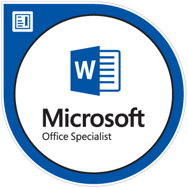Computer Applications | Microsoft Office | Microsoft Office Specialist (MOS) | Industry Certifications
What Is the MOS Word Associate Certification?
McKenna Garrison joined the iCEV marketing team in 2022 as the Content Marketing Specialist. Originally from a small town on the Gulf of Mexico, Garrison attended Texas Tech University from which she graduated with a B.A. in Public Relations & Strategic Community and an M.A. in Mass Communication & Media Studies. Garrison looks forward to bringing more of a storytelling element to iCEV social media pages. She also hopes to connect other CTE educators from around the country to the incredible curricula and resources iCEV has to offer.
When students earn the MOS Word Associate certification, they have the support of Microsoft to prove that they are proficient with Word.
Because the MOS Word Associate certification is the only Microsoft-recognized basic Word certification, teachers across the country incorporate it into their computer applications courses.
In addition, many employers look for proficiency in Microsoft Word in new hires, and the MOS Word Associate certification proves those skills.
So how do you know you’re teaching the right information to help your students become MOS Word certified?
On this page, you’ll get an in-depth look at the concepts and skills on the MOS Word Associate exam.
We’ll also share a few tips to help prepare your students for the certification.
But before we get into the details of the MOS Word exam, let’s discuss the overarching MOS Certification Program!
What Is the MOS Certification Program?
The Microsoft Office Specialist (MOS) certification program is designed to assess someone’s knowledge and skills with Microsoft Office applications.
The MOS certification program was first launched by Microsoft in 2010 as a way to help prepare students for college and the workplace.
The certification program is administered by Certiport, a well-known provider of curriculum resources and certifications.
The MOS certification program includes exams for seven Microsoft applications:
- Word
- Excel
- PowerPoint
- Access
- Outlook
- OneNote
- SharePoint
Certiport provides exams for multiple versions of each application (2016, 2019, and 365) and some applications have expert and master level certification options.
These variations add up to more than 20 different MOS certifications across the Microsoft Office application suite!
We’ll focus specifically on the Microsoft Office Specialist Word Associate 2019/365 Exam (Exam MO-100) because it’s the most commonly used MOS certification at the time of publication.
Now that you know about the MOS certification program as a whole, let’s get into the details of the MOS Word exam!
How Is the MOS Word Certification Structured?
The MOS Word Associate 2019/365 exam proves students have mastered document creation, collaboration, and communication when using Word.
The exam is made up of 35 questions across six objective domains:
- Manage Documents
- Insert and Format Text, Paragraphs, and Sections
- Manage Tables and Lists
- Create and Manage References
- Insert and Format Graphic Elements
- Manage Document Collaboration
Each domain includes a varying number of concepts and skills students need to know to become proficient with Microsoft Word.
Domain 1 - Manage Documents
The Manage Documents domain includes four subdomains:
- 1.1 - Navigate within documents
- 1.2 - Format documents
- 1.3 - Save and share documents
- 1.4 - Inspect documents for issues
In total, there are 15 concepts and tasks students must know, such as applying style sets, inserting headers, and modifying print settings.
Domain 2 - Insert and Format Text, Paragraphs, and Sections
The Insert and Format Text, Paragraphs, and Sections domain is made up of three subdomains:
- 2.1 - Insert text and paragraphs
- 2.2 - Format text and paragraphs
- 2.3 - Create and configure document sections
Overall, these subdomains contain 10 tasks, including inserting symbols, applying text effects, and inserting page breaks.
Domain 3 - Manage Tables and Lists
The Manage Tables and Lists domain includes three subdomains:
- 3.1 - Create tables
- 3.2 - Modify tables
- 3.3 - Create and modify lists
In total, there are 15 specific tasks students should be able to complete, such as converting text to tables, sorting table data, merging table cells, and creating a numbered list.
Domain 4 - Create and Manage References
The Create and Manage References domain includes two subtopics:
- 4.1 - Create and manage reference elements
- 4.2 - Create and manage reference tables
These subtopics are made up of seven tasks, such as inserting footnotes, creating bibliography citation sources, and inserting a table of contents.
Domain 5 - Insert and Format Graphic Elements
The Insert and Format Graphic Elements domain has four subdomains:
- 5.1 - Insert illustrations and text boxes
- 5.2 - Format illustrations and text boxes
- 5.3 - Add text to graphic elements
- 5.4 - Modify graphic elements
In total, this domain has 18 tasks related to graphic elements, such as inserting shapes, formatting graphic elements, positioning objects, and creating SmartArt graphics.
Domain 6 - Manage Document Collaboration
The Manage Document Collaboration includes two subdomains:
- 6.1 - Add and manage comments
- 6.2 - Manage change tracking
These subdomains are made up of eight tasks, such as adding comments, resolving comments, tracking changes, and locking change tracking.
Summary: The MOS Word Associate 2019 Exam
Overall, students have 50 minutes to complete the MOS Word Associate certification exam.
When they pass, they receive the Microsoft Office Specialist Word Associate 2019 digital badge and are officially MOS Word certified!
Now that you know the details of what’s on the MOS exam, how will you prepare your students for success?
How Do You Prepare Students for the MOS Word Certification?
Preparing your students to take the MOS Word exam involves more than you may anticipate.
You may be tempted to head straight for the test prep materials.
Study guides and practice tests are a great way to measure how ready your students are for the exam, but they don’t actually help you teach the material!
On top of that, teaching to the test can harm your student’s long-term retention and accidentally lead you to skip important information that the exam doesn’t cover.
That’s why it’s best to take a two-step approach when preparing your students for the MOS Word Associate exam:
- Teach your curriculum
- Prep for the exam
This approach lets you show students the information they need to succeed with Microsoft Word, and then you use the MOS Word Associate certification as a capstone for the marking period!
To start, teach the foundational Microsoft Word skills students will need to know for the exam and their future careers.
To do this, you’ll need a tried-and-true curriculum that highlights the foundational concepts students need to learn more advanced information about Microsoft Word.
If you have specific course standards, you’ll want to meet those as well!
After you’ve covered the basics, switch gears toward the end of the semester to focus more specifically on the exam.
This is a great time to break out the test prep materials to help your students review before test day.
Overall, this process is surprisingly easy, even for first-time computer applications teachers. For this process to run smoothly, you need to find a good balance between teaching the material and focusing on the exam.
That’s why so many teachers use a comprehensive curriculum to do the heavy lifting when it comes to teaching Microsoft Word skills for the MOS exam!
Thousands of teachers across the United States use iCEV to teach computer applications classes and prep students for the MOS Word Associate exam.
iCEV's MOS curriculum is designed to make your life easier and help your students earn the MOS Word Associate certification with pre-made curriculum, automatic grading, and on-demand access that you can use at any time.
Want to learn more about how you can prepare students for the MOS Word Associate Exam with iCEV? Visit the certification alignment page to discover how iCEV meets standards to ensure students succeed on test day.


